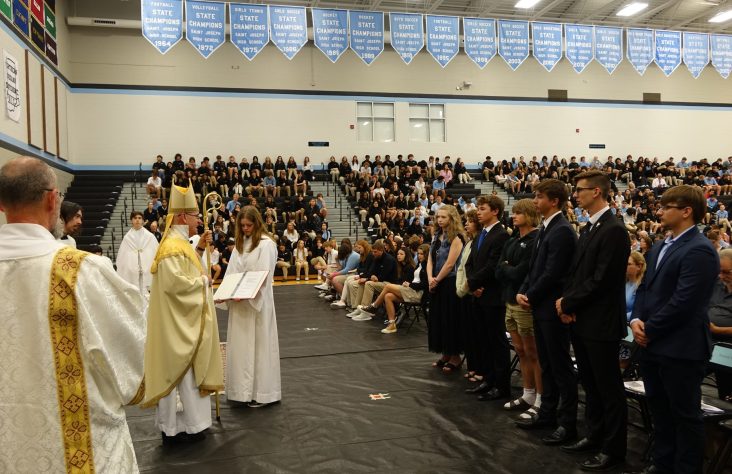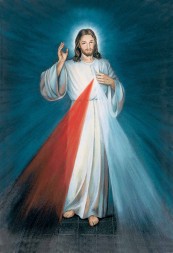April 18, 2017 // Special
Learning to live the liturgical calendar: Divine Mercy Sunday
“There is nothing that man needs more than Divine Mercy.” St. John Paul II spoke these words at the grave of St. Sister Faustina Kowalska, Krakow, Poland in 1997. He then dedicated the entire world to God’s Divine Mercy, realizing the centrality of this key aspect of the Gospel.
St. M. Faustina Kowalska (1905-1938) was a faithful, simple mystic and religious sister of the Congregation of Sisters of Our Lady of Mercy. She is also known as the Apostle of the Divine Mercy, due to her regular visions of and conversations with Jesus, which led to the promulgation of the devotion. In obedience to Jesus’ specific requests, she saw to it that the feast of Divine Mercy was begun to commemorate Christ’s redemptive love and mercy, complete with special prayers, a chaplet and an image.
Divine Mercy Sunday takes place the first Sunday after Easter. Here, the beauty of the Catholic liturgical calendar begins to shine through, connecting the historical with the present reality.
The novena and image of Divine Mercy
The Divine Mercy novena starts on Good Friday, the day when Jesus gave His ultimate gift, His life, for all people — freely, fully and humbly. The redemption of sins through His sacrifice on the cross is the great act of love. It is love that kept Jesus there. Imagine, then, the grace that flows, both literally and spiritually, from the cross to the believer for the next nine days of prayer.
The image of Divine Mercy shows that grace, which we know spiritually exists. The resurrected person of Jesus Christ stands, walking towards the viewer, victorious, with the holes of the crucifixion in His hands, blessing them with His right hand and pulling open His sacred heart with His left. From His heart stream beams of white and red, rays of water and blood, respectively. Through the dark, through the waiting and mourning time in the tomb to the bright morning light of Easter Sunday resurrection, the grace and light from the side of Jesus’ side can to this day illuminate the lives of those who believe. Truly these nine days offer great grace, available to every person.
In the image of Divine Mercy, one observes the reflection of three sacraments: baptism, penance and Eucharist. On this day, the church reads in the Gospel according to St. John (Jn. 20:19-29) about the risen Christ appearing in the upper room and the institution of the sacrament of penance. Ever the merciful father, God yearns for His children to return home and thus offers them Jesus, the Divine Mercy and mediator. Jesus is present to the viewer, walking towards them, offering, once again, His peace.
In speaking to St. Faustina, Jesus explained, “My mercy is greater than your sins and those of the entire world. Who can measure the extent of my goodness? For you, I descended from heaven to earth; for you I allowed myself to be nailed to the cross; for you I let my sacred heart be pierced with a lance, thus opening wide the source of mercy for you. Come, then, with trust to draw graces from this fountain. I never reject a contrite heart.”
Through the pale-colored ray, that of water, a soul is washed clean in baptism, which makes it righteous. Through the red ray, that of Christ’s own blood, a soul is fed by the Eucharist, which is the life of souls. “The sacrament of baptism and penance purify the soul, and the Eucharist most abundantly nourishes it,” said St. Faustina.
Under the guidance of her confessor, Father Michael Sopocko, St. Faustina directed the creation and painting of the image of the Divine Mercy, which Jesus himself told her to have made. This is the only known portrait of Jesus that He himself guided to be painted. In 1931, St. Faustina had a vision of this image and heard Jesus saying to her: “Paint an image according to the pattern you see, with the signature: Jesus, I trust in You.”
The liturgical connection
Easter celebrates the Lord’s triumph over death. It is the holy day that changes everything, that makes Christians Christian. Thus, it is the pinnacle of the Roman Catholic liturgical year and is celebrated as such. For a full octave of days, Easter is celebrated every day. The names Easter Monday, Easter Tuesday, etc., sound repetitive, but offer a hint of the significance of the gift given at the Resurrection.
What, then, would best complete such a continual feast? Perhaps the devotion that offers a pathway of grace to live this new life, Divine Mercy.
At the Lord’s direction to St. Faustina, the Divine Mercy Chaplet is to be prayed the Sunday after Easter, while the soul is awash in the love and purity of the Paschal Mystery, when Jesus’ merciful and compassionate heart is especially open to all contrite people.
The origin of the feast
Jesus told St. Faustina, in her visions while she was on a retreat in 1936, of three ways His Divine Mercy was to be exercised: through deed, word and prayer. He wanted a celebration of His feast of mercy and veneration of the Divine Mercy image, as well as acts of mercy shown on earth, “because even the strongest faith is of no avail without works.”
In her diary, which St. Faustina was told to write by her spiritual director and her superior, she recorded Jesus saying to her: “I desire that the Feast of Mercy be a refuge and shelter for all souls, and especially for poor sinners. On that day, the very depths of My tender mercy are open. I pour out a whole ocean of graces upon those souls who approach the fount of My mercy. The souls that will go to Confession and receive Holy Communion shall obtain complete forgiveness of sins and punishment. On that day are open all the divine floodgates through which graces flow.”
Detractors argue that it is simply a cultural, local feast, not a universal one; but theologians in the last 50 years have reclaimed the deep scriptural and traditional roots of mercy that St. Faustina heard of in her visions of Jesus. Also, throughout the Bible, God’s work in and with humanity is through human history, through the local and specific, for the universal salvation of all people. Jesus was born into a specific family, culture and heritage, but for the salvation of the whole world.
Pope Benedict XVI spoke to this situation when he preached in 2006 on Divine Mercy Sunday, “The Servant of God John Paul II … wanted the Sunday after Easter to be dedicated in a special way to Divine Mercy, and providence disposed that he should die precisely on the vigil of that day (in the hands of Divine Mercy). …Let us recall, in particular, the encyclical Dives in Misericordia of 1980, and the dedication of the new shrine of Divine Mercy in Krakow, in 2002. The words he pronounced on that last occasion were as a synthesis of his magisterium, evidencing that devotion to Divine Mercy is not a secondary devotion, but an integral dimension of a Christian’s faith and prayer.”
Pope Francis, like St. John Paul II and Pope Benedict XVI, has made mercy a central theme in his pontificate. In “Misericordiae Vultus,” he wrote, “Mercy is the very foundation of the Church’s life. All her pastoral activity should be caught up in the tenderness she makes present to believers; nothing in her preaching and in her witness to the world can be lacking in mercy. The Church’s very credibility is seen in how she shows merciful and compassionate love.” Most recently he proclaimed a Year of Mercy, highlighting this key element of Christianity. This special year included his visit to World Youth Day in Krakow, Poland, which highlighted St. Faustina’s gift to the world.
Divine Mercy today
Celebrate the feast: Jesus offered the feast of Divine Mercy to all people everywhere. When there is such extreme violence and unrest in the news, Divine Mercy is the key against the evil in the world. Jesus said to St. Faustina, “On this day the very depths of My tender mercy are open. I pour out a whole ocean of graces upon those souls who approach the font of my mercy… Let no soul fear to draw near to Me, even though its sins be as scarlet.”
Practice corporal and spiritual works of mercy: In everyday life, each person is given opportunities daily to show God’s great mercy. St. Faustina, in her last years of life before dying of tuberculosis at age 33, was the doorkeeper for her convent. She wrote about the humble job, “Oh, how happy I am that my superiors have given me such a task! I understand that mercy is manifold, one can do good always and everywhere and at all times. An ardent love of God sees all around itself constant opportunities to share itself through deed, word and prayer.” We are to be apostles of mercy; we must be vessels of mercy to others. For that which we have received, we are to give.
The best news. Delivered to your inbox.
Subscribe to our mailing list today.







